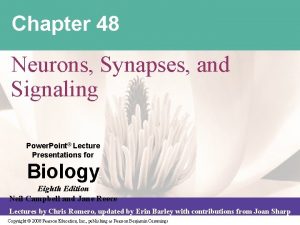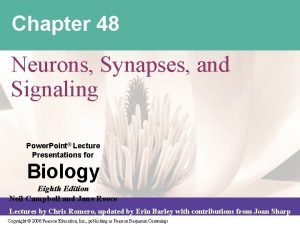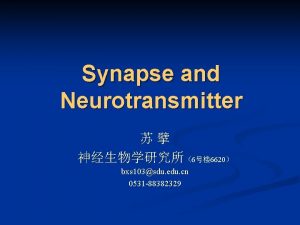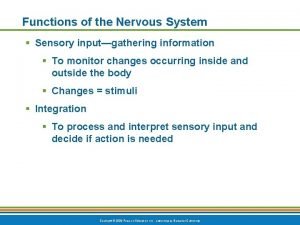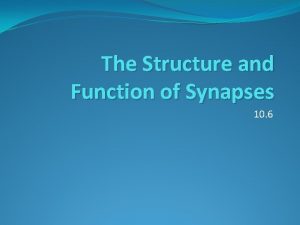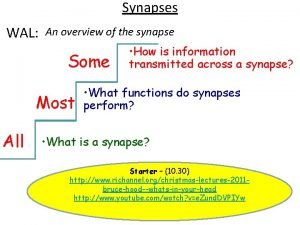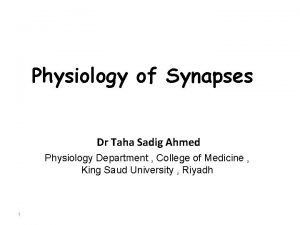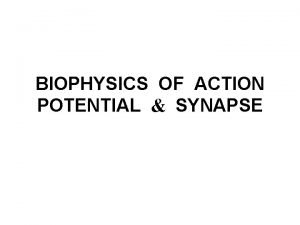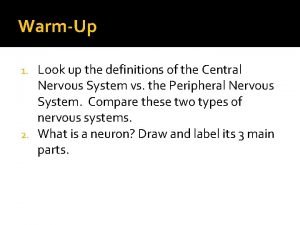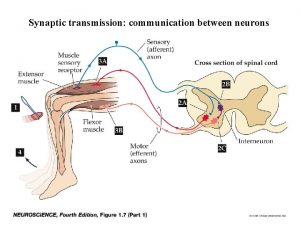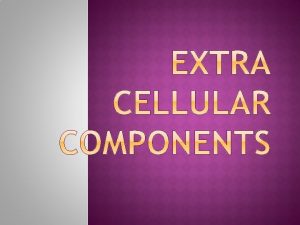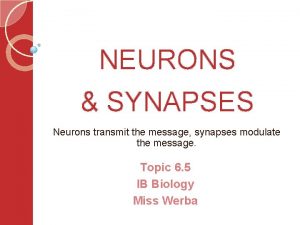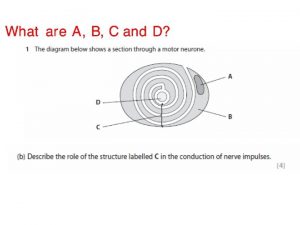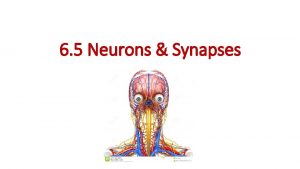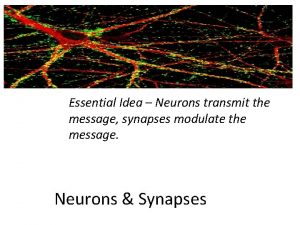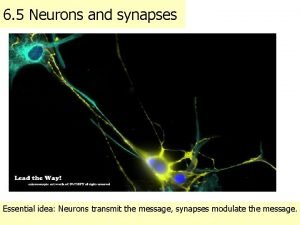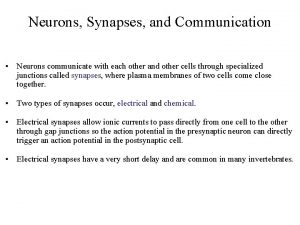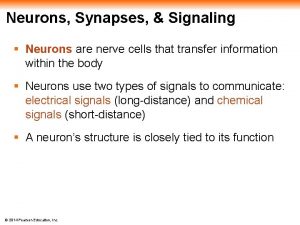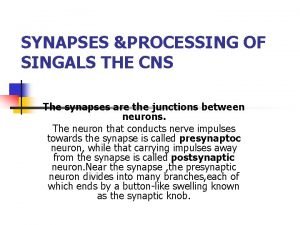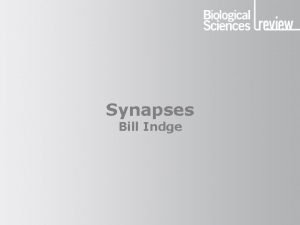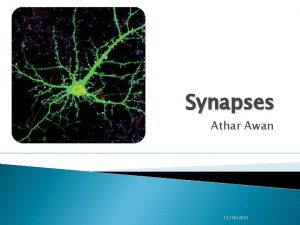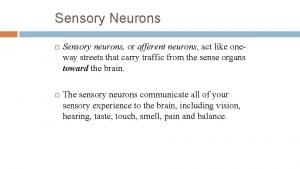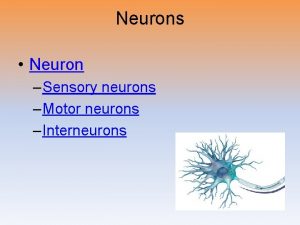6 5 NEURONS AND SYNAPSES Neurons Neurons transmit















- Slides: 15

6. 5 NEURONS AND SYNAPSES

Neurons ■ Neurons transmit electrical impulses. ■ Two systems of the body are used for internal communications – The endocrine system ■ Consists of glands that release hormones. – The nervous system ■ ■ Consists of nerve cells called neurons. There about 85 billion neurons in the human nervous system. ■ Neurons help with internal communication by transmitting nerve impulses. ■ Nerve impulses are an electrical signal.

Short branched nerve fibers Transmit impulses between neurons Cytoplasm & nucleus Elongated nerve fibers Tips of toes/fingers to spinal cord Allows for salutatory conduction -jumping between node of Ranvier -Much quicker than continuous transmission.

Resting Potential ■ Neurons pump sodium and potassium ions across their membranes to generate a resting potential. ■ A neuron that is not transmitting a signal has a potential difference or voltage across its membrane. (resting potential). ■ This potential is due to the imbalance of positive and negative charges across the membrane. ■ Resting potential (-70 m. V).

Action Potential ■ An action potential consists of depolarization and repolarization of the neuron. ■ An AP is a rapid change in the membrane potential, consisting of two phases. ■ 1. Depolarization – a change from negative to positive – Due to opening of sodium (Na+) channels in the membrane, allowing sodium ions to diffuse into the neuron down the concentration gradient. – Raises membrane potential to about +30 m. V. ■ 2. Repolarization – a change from positive to negative – Closing of sodium channels and opening of potassium channels. – K+ ions diffuse out of the membrane. – Makes inside cell negative in relation to the outside of the cell. – Channel remains open until membrane has fallen to a potential close to -70 m. V. – This does not restore the resting potential as the concentration gradients have not be re-established. – This takes a few milliseconds. – *Like when you flush the toilet.


Propagation of action potentials ■ Nerve impulses are action potentials propagated along the axons of neurons. ■ A nerve impulse is an action potential that starts at one end of a neuron and is then propagated along the axon to the other end of the neuron. ■ The propagation of the AP happens because the ion movements that depolarize one part of the neuron trigger depolarization in the neighboring part of the neuron. ■ Nerve impulses always move in one direction along neurons, because an impulse can only be initiated at one terminal of a neuron and can only be passed on to other neurons/different cell types at the other terminal.

Local Currents ■ Propagation of nerve impulses is the result of local currents that cause each successive part of the axon to reach the threshold potential.

DBQ

Synapses ■ Synapses are junctions between neurons and receptors or effector cells. ■ Synapses are junctions between cells in the nervous system. ■ Chemicals called neurotransmitters are used to send signals across synapses.

Synaptic transmission ■ When pre-synaptic neurons are depolarized they release a neurotransmitter into the synapse. ■ Synaptic transmission occurs very rapidly as a result of these events: – A nerve impulse is propagated along the pre-synaptic neuron until it reaches the end of the neuron and the pre-synaptic membrane. – Depolarization of the pre-synaptic membrane causes calcium ions to diffuse through channels in the membrane into the neuron. – Influx of calcium causes vesicles containing neurotransmitters to move to the pre-synaptic membrane and fuse with it. – Neurotransmitters diffuses across the synaptic cleft and binds to receptors on the post-synaptic membrane. – The binding of the neurotransmitters to the receptors causes adjacent sodium ion channels to open. – Sodium ions diffuse down the concentration gradient into the post-synaptic neuron, causing the post-synaptic neuron to reach the threshold potential. – An AP is triggered in the post-synaptic membrane and propagated on along the neuron. – The neurotransmitter is quickly broken down and removed from the synaptic cleft.

Acetylcholine ■ Secretion and reabsorption of acetylcholine by neurons at synapses. ■ Acetylcholine is used as the neurotransmitter in many synapses, including synapses between neurons and muscle fibers. ■ It is produced in the pre-synaptic neuron by combining choline (absorbed from the diet) with an acetyl group produced during aerobic respiration.

Threshold potential ■ A nerve impulse is only initiated if the threshold potential is reached. ■ Nerve impulses follow an all-or-nothing principle. ■ An AP is only initiated if the threshold potential is reached, because only at this potential do voltage-gated sodium channels start to open, causing depolarization. ■ At a synapse, the amount of neurotransmitter secreted following depolarization of the pre-synaptic membrane may not be enough to cause threshold potential to be reach in the post-synaptic membrane. ■ The post-synaptic membrane does not depolarize. ■ The sodium ions that have entered the post-synaptic neuron are pumped out by sodium-potassium pumps, returning the post-synaptic membrane to a resting potential.

Neonicotinoids ■ Blocking of synaptic transmission at cholinergic synapses in insects by binding of neonicotinoid pesticides to acetylcholine receptors. ■ Neonicotinoids are synthetic compounds similar to nicotine. ■ The bind to the acetylcholine receptor in cholinergic synapses in the central nervous system (CNS) of insects. ■ Acetylcholine does not break down neonicotinoids, so the binding is irreversible. ■ The receptors are blocked, so acetylcholine is unable to bind and synaptic transmission is prevented. ■ The insect is paralysis and dies. ■ Neonicotinoids are very effective pesticides. ■ Pros: Not highly toxic to humans and other animals. ■ Cons: The effects is has on honey bees and other beneficial insects.

Homework ■ Study for Quiz on 6. 5 ■ Research a drug and how it impacts synaptic transmission in the brain. ■ 1 page, at least 1 source ■ It can be a legal (prescribed/over the counter) drug or an illegal drug. ■ Due next class.
 Chapter 48 neurons synapses and signaling
Chapter 48 neurons synapses and signaling Chapter 48 neurons synapses and signaling
Chapter 48 neurons synapses and signaling Deoxyribose nucleotide
Deoxyribose nucleotide 2 types of synapses
2 types of synapses How is one-way conduction at synapses ensured
How is one-way conduction at synapses ensured Synapse functions
Synapse functions Synapses telecom
Synapses telecom Functions of a synapse
Functions of a synapse Taha kass-hout
Taha kass-hout Summation of postsynaptic potentials
Summation of postsynaptic potentials Bioflix how synapses work
Bioflix how synapses work Chemical synapses
Chemical synapses Central nervous system divisions
Central nervous system divisions Layers of cell wall
Layers of cell wall How does the approaching ceremony of twelves affect jonas
How does the approaching ceremony of twelves affect jonas Transmit diversity in lte
Transmit diversity in lte
